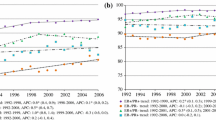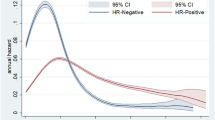Abstract
Background. Breast cancer is a heterogeneous and chronic disease with relapses and death occurring 25 years or more after primary diagnosis. Standard tumor characteristics are used to predict initial relapse or death, but their ability to estimate long-term patterns of failure may be limited.
Methods. To further evaluate the significance of standard tumor features, we compared incidence and prognostic patterns in the National Cancer Institute’s (NCI’s) large-scale population-based Surveillance, Epidemiology, and End Results (SEER) program for high-risk versus low-risk breast cancers, i.e., size >2.0 versus ≤ 2.0 cm, lymph node positive versus negative, high versus low histologic grade, and hormone receptor negative versus positive expression, respectively. Data were stratified by age 50 years to approximate menopause.
Results. High-risk versus low-risk breast cancers demonstrated two very different incidence and prognostic patterns. Age-specific incidence rates among women with high-risk tumors increased until age 50 years then flattened, whereas rates among women with low-risk tumors increased continuously with aging. Hazard rates for breast cancer death spiked sharply two years following primary breast cancer diagnosis among women with high-risk but not with low-risk tumors. Paradoxically, hazard function crossed over 6–8 years following breast cancer diagnosis, with hazard rates lower for high-risk than for low-risk breast cancers.
Conclusion. Distinct incidence and prognostic patterns among high-risk and low-risk breast cancers suggest a possible link between breast cancer etiology and outcome. These epidemiologic results appear to complement emerging molecular genetic techniques, showing distinct genotypes for high-risk and low-risk breast cancer phenotypes.
Similar content being viewed by others
References
SG Hilsenbeck PM Ravdin CA de Moor GC Chamness CK Osborne GM Clark (1998) ArticleTitleTime-dependence of hazard ratios for prognostic factors in primary breast cancer Breast Cancer Res Treat 52 IssueID3 227–237 Occurrence Handle10066085 Occurrence Handle1:STN:280:DyaK1M7mtl2lug%3D%3D
MJ McKay AO Langlands (1992) ArticleTitlePrognostic factors in breast cancer. New England J Med 327 IssueID18 1317 Occurrence Handle1:STN:280:DyaK3s%2FisVOntQ%3D%3D Occurrence Handle10.1056/NEJM199210293271815
JE Devitt (1965) ArticleTitleThe significance of regional lymph node metastases in breast carcinoma Can Med Assoc J 93 289–293 Occurrence Handle14319790 Occurrence Handle1:STN:280:DyaF2M7isVClsw%3D%3D
I MacDonald (1951) ArticleTitleBiological predeterminism in human cancer Surg Gynecol Obstet 92 443–452 Occurrence Handle14835200 Occurrence Handle1:STN:280:DyaG3M%2FmsVOmsg%3D%3D
MJ van de Vijver YD He LJ van’t Veer H Dai AA Hart DW Voskuil et al. (2002) ArticleTitleA gene-expression signature as a predictor of survival in breast cancer N Engl J Med 347 IssueID25 1999–2009 Occurrence Handle10.1056/NEJMoa021967 Occurrence Handle12490681 Occurrence Handle1:CAS:528:DC%2BD38Xps1Ojt7w%3D
R Bernards RA Weinberg (2002) ArticleTitleMetastasis genes: A progression puzzle. Nature 418 IssueID6900 823 Occurrence Handle12192390 Occurrence Handle1:CAS:528:DC%2BD38XmtlWlsLw%3D
SEER. Surveillance, Epidemiology, and End Results (SEER) Program. Public-Use Database (1973–2001), National Cancer Institute, DCCPS, Surveillence Research Program, Cancer Statistics Branch, based on the November 2003 submission. 2004; www.seer.cancer.gov.
A Morabia P Flandre (1992) ArticleTitleMisclassification bias related to definition of menopausal status in case–control studies of breast cancer Int J Epidemiol 21 IssueID2 222–228 Occurrence Handle1428473 Occurrence Handle1:STN:280:DyaK3s%2FltlWgug%3D%3D
O Miettinen M Nurminen (1985) ArticleTitleComparative analysis of two rates Stat Med 4 IssueID2 213–226 Occurrence Handle4023479 Occurrence Handle1:STN:280:DyaL2M3ntF2jtg%3D%3D
P Armitage R Doll (1954) ArticleTitleThe age distribution of cancer and a multi-stage theory of carcinogenesis Br J Cancer 8 1–12 Occurrence Handle13172380 Occurrence Handle1:STN:280:DyaG2c%2Fpt1Ckuw%3D%3D
P Armitage R Doll (1957) ArticleTitleA two-stage theory of carcinogenesis in relation to the age distribution of human cancer Br J Cancer 11 IssueID2 161–169 Occurrence Handle13460138 Occurrence Handle1:STN:280:DyaG1c%2Fgt1OqsQ%3D%3D
WF Anderson KC Chu N Chatterjee OW Brawley LA Brinton (2001) ArticleTitleTumor variants by hormone receptor expression in white patients with node-negative breast cancer from the Surveillance, Epidemiology, and End Results database J Clin Oncol 19 IssueID1 18–27 Occurrence Handle11134191 Occurrence Handle1:CAS:528:DC%2BD3MXot1Wgsg%3D%3D
WF Anderson N Chatterjee WB Ershler OW Brawley (2002) ArticleTitleEstrogen receptor breast cancer phenotypes in the surveillance, epidemiology, and end results database Breast Cancer Res Treat 76 IssueID1 27–36 Occurrence Handle12408373 Occurrence Handle1:CAS:528:DC%2BD38XntVKjtbo%3D
EL Kaplan P Meier (1958) ArticleTitleNonparametric estimation from incomplete observations J Am Stat Assoc 53 457–481
R Peto J Peto (1972) ArticleTitleAsymptomatically efficient rank invariant test procedures J R Stat Soc A 135 IssueIDA 185–198 Occurrence Handle10.2307/2344317
DR Cox (1972) ArticleTitleRegression models and life-tables J R Stat Soc B 34 187–220
LA Brinton J Benichou MD Gammon DR Brogan R Coates JB Schoenberg (1997) ArticleTitleEthnicity and variation in breast cancer incidence Int J Cancer 73 IssueID3 349–355 Occurrence Handle9359481 Occurrence Handle1:STN:280:DyaK1c%2Fit1Cguw%3D%3D
Y Yasui JD Potter (1999) ArticleTitleThe shape of age-incidence curves of female breast cancer by hormone-receptor status Cancer Causes Control 10 IssueID5 431–437 Occurrence Handle10530614 Occurrence Handle1:STN:280:DyaK1MvlvVWqtQ%3D%3D
RE Tarone KC Chu (2002) ArticleTitleThe greater impact of menopause on ER- than ER+ breast cancer incidence: a possible explanation (United States) Cancer Causes Control 13 7–14 Occurrence Handle11899120
AM Lilienfeld EA Johnson (1955) ArticleTitleThe age distribution in female breast and genital cancers Cancer 8 875–882 Occurrence Handle13261037 Occurrence Handle1:STN:280:DyaG28%2Fht12mtw%3D%3D
AG Knudson (2001) ArticleTitleTwo genetic hits (more or less) to cancer Nat Rev Cancer 1 IssueID2 157–62 Occurrence Handle10.1038/35101031 Occurrence Handle11905807 Occurrence Handle1:CAS:528:DC%2BD38XlvF2qsLg%3D
J Clemmesen (1948) ArticleTitleCarcinoma of the breast Br J Radiol 21 IssueID252 583–590 Occurrence Handle18099749 Occurrence Handle1:STN:280:DyaH1M%2FgtFentw%3D%3D Occurrence Handle10.1259/0007-1285-21-252-583
E Anderson (1950) ArticleTitlePossible relationship between menopause and age at onset of breast cancer Cancer 3 410–411 Occurrence Handle15414462 Occurrence Handle1:STN:280:DyaG3c%2FisVSqtg%3D%3D
WF Anderson (2003) ArticleTitlePuberty and genetic susceptibility to breast cancer (letter) N Engl J Med 349 IssueID11 1088–1089 Occurrence Handle12971365
WF Anderson MD Althuis LA Brinton SS Devesa (2004) ArticleTitleIs male breast cancer similar or different than female breast cancer Breast Cancer Res Treat 83 77–86 Occurrence Handle14997057
DB Thomas (1993) ArticleTitleBreast cancer in men Epidemiol Rev 15 IssueID1 220–231 Occurrence Handle8405206 Occurrence Handle1:STN:280:DyaK2c%2FgvFCjug%3D%3D
KS Albain DC Allred GM Clark (1994) ArticleTitleBreast cancer outcome and predictors of outcome: are there age differentials J Nat Cancer Inst Monograph 16 35–42
SG Diab RM Elledge GM Clark (2000) ArticleTitleTumor characteristics and clinical outcome of elderly women with breast cancer J Natl Cancer Inst 92 IssueID7 550–556 Occurrence Handle10.1093/jnci/92.7.550 Occurrence Handle1:STN:280:DC%2BD3c3hsFSgsg%3D%3D Occurrence Handle10749910
I Jatoi A Tsimelzon H Weiss GM Clark SG Hilsenbeck (2005) ArticleTitleHazard rates of recurrence following diagnosis of primary breast cancer Breast Cancer Research and Treatment 2004 89 173–178
A Ahr T Karn C Solbach T Seiter K Strebhardt U Holtrich et al. (2002) ArticleTitleIdentification of high risk breast-cancer patients by gene expression profiling Lancet 359 IssueID9301 131–132 Occurrence Handle11809257
E Huang SH Cheng H Dressman J Pittman MH Tsou CF Horng et al. (2003) ArticleTitleGene expression predictors of breast cancer outcomes Lancet 361 IssueID9369 1590–1596 Occurrence Handle10.1016/S0140-6736(03)13308-9 Occurrence Handle1:CAS:528:DC%2BD3sXjs1Wltbo%3D Occurrence Handle12747878
C Sotiriou SY Neo LM McShane EL Korn PM Long A Jazaeri et al. (2003) ArticleTitleBreast cancer classification and prognosis based on gene expression profiles from a population-based study Proc Natl Acad Sci U S A 100 IssueID18 10393–10398 Occurrence Handle12917485 Occurrence Handle1:CAS:528:DC%2BD3sXntFynsrk%3D
M West C Blanchette H Dressman E Huang S Ishida R Spang et al. (2001) ArticleTitlePredicting the clinical status of human breast cancer by using gene expression profiles Proc Natl Acad Sci U S A 98 IssueID20 11462–11467 Occurrence Handle11562467 Occurrence Handle1:CAS:528:DC%2BD3MXnt1yqu7w%3D
D Easton (2000) ArticleTitleBreast cancer-not just whether but when Nat Genet 26 IssueID4 390–391 Occurrence Handle11101827 Occurrence Handle1:CAS:528:DC%2BD3cXptVWgsLc%3D
CM Perou T Sorlie MB Eisen M Rijn Particlevan de SS Jeffrey CA Rees et al. (2000) ArticleTitleMolecular portraits of human breast tumours Nature 406 IssueID6797 747–752 Occurrence Handle10.1038/35021093 Occurrence Handle10963602 Occurrence Handle1:CAS:528:DC%2BD3cXmt1CnsLw%3D
T Sorlie R Tibshirani J Parker T Hastie JS Marron A Nobel et al. (2003) ArticleTitleRepeated observation of breast tumor subtypes in independent gene expression data sets Proc Natl Acad Sci U S A 100 IssueID14 8418–8423 Occurrence Handle12829800 Occurrence Handle1:CAS:528:DC%2BD3sXlsFGntLk%3D
W Boecker H Buerger (2003) ArticleTitleEvidence of progenitor cells of glandular and myoepithelial cell lineages in the human adult female breast epithelium: a new progenitor (adult stem) cell concept Cell Prolif 36 IssueID1 Suppl 73–84 Occurrence Handle14521517
C Jones AV Nonni L Fulford S Merrett R Chaggar V Eusebi et al. (2001) ArticleTitleCGH analysis of ductal carcinoma of the breast with basaloid/myoepithelial cell differentiation Br J Cancer 85 IssueID3 422–427 Occurrence Handle10.1054/bjoc.2001.1869 Occurrence Handle11487275 Occurrence Handle1:STN:280:DC%2BD3MvktFCmtA%3D%3D
WD Foulkes JS Brunet IM Stefansson O Straume PO Chappuis LR Begin et al. (2004) ArticleTitleThe prognostic implication of the basal-like (cyclin E high/p27 low/p53+/glomeruloid-microvascular-proliferation+) phenotype of BRCA1-related breast cancer Cancer Res 64 IssueID3 830–835 Occurrence Handle14871808 Occurrence Handle1:CAS:528:DC%2BD2cXhtFCgtLo%3D
R Kesse-Adu S Shousha (2004) ArticleTitleMyoepithelial markers are expressed in at least 29% of oestrogen receptor negative invasive breast carcinoma Mod Pathol 17 IssueID6 646–652 Occurrence Handle15073596 Occurrence Handle1:CAS:528:DC%2BD2cXmsVOisLY%3D
IC Henderson AJ Patek (1998) ArticleTitleThe relationship between prognostic and predictive factors in the management of breast cancer. Breast Cancer Res Treat 52 IssueID(1–3) 261–288 Occurrence Handle10066087 Occurrence Handle1:STN:280:DyaK1M7mtl2ksg%3D%3D
WF Anderson KC Chu S Chang ME Sherman (2004) ArticleTitleComparison of age-specific incidence rate patterns for different histopathologic types of breast carcinoma Cancer Epidemiol, Biomarkers Prev 13 IssueID7 1128–1135
WF Anderson KC Chu SS Devesa (2004) ArticleTitleDistinct incidence patterns among in-situ and invasive breast carcinomas, with possible etiologic implications Breast Cancer Res Treat 88 149–159 Occurrence Handle15564798
S Hellman (1994) ArticleTitleNatural history of small breast cancers. J Clin Oncol 12 IssueID10 2229–2234 Occurrence Handle7931493 Occurrence Handle1:STN:280:DyaK2M%2Fhs1yqsg%3D%3D
Author information
Authors and Affiliations
Corresponding author
Rights and permissions
About this article
Cite this article
Anderson, W.F., Jatoi, I. & Devesa, S.S. Distinct breast cancer incidence and prognostic patterns in the NCI’s SEER program: suggesting a possible link between etiology and outcome. Breast Cancer Res Treat 90, 127–137 (2005). https://doi.org/10.1007/s10549-004-3777-3
Issue Date:
DOI: https://doi.org/10.1007/s10549-004-3777-3




